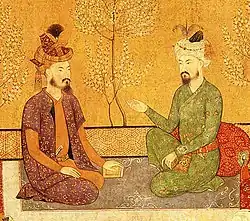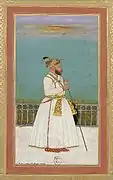Qaba
Qaba (Persian: قباqabā) is a long coat with sleeves and buttons, similar to a cassock, open at the front. Qaba is similar to a wadded coat. The Mughal emperors wear ankle-length garment. The outfits during the reign of Babur and Humayun are more or less the same i.e. qaba, Jama, pirahan, jilucha, jiba and kasaba. Unlike jama which was a four pointed long-coat the Qaba and takauchia were of a broad girth at the bottom. There are mentions about Qaba in the Baburnama. At present, Qaba is one of the essential parts of the dress of the Islamic clerics or mosque leaders.[1][2][3][4][5][6][7][8]
See also
Gallery
 Babur and his heir Humayun
Babur and his heir Humayun Late 17th century portrait of Fírúz Jang Khán, ruler of Bijapur
Late 17th century portrait of Fírúz Jang Khán, ruler of Bijapur Late 19th century "Costume of India - Moguls" picture depicting Mogul woman (upper left), Mogul Emperor Farrukhsiyar (center) died 1719, and Emperor Humayun (upper right), died in 1556
Late 19th century "Costume of India - Moguls" picture depicting Mogul woman (upper left), Mogul Emperor Farrukhsiyar (center) died 1719, and Emperor Humayun (upper right), died in 1556 Vizier Qamar ud-Din circa 1735
Vizier Qamar ud-Din circa 1735 Portrait of "Mogul" father with his children in Delhi (Shepherd & Robertson) circa 1863
Portrait of "Mogul" father with his children in Delhi (Shepherd & Robertson) circa 1863
References
- Balslev, Sivan (2019-03-21). Iranian Masculinities: Gender and Sexuality in Late Qajar and Early Pahlavi Iran. Cambridge University Press. p. 208. ISBN 978-1-108-47063-6.
- Johnson, Francis (1852). A Dictionary, Persian, Arabic, and English. Allen. p. 254.
- Islamic Thought and Scientific Creativity: A Quarterly Journal of the COMSTECH. COMSTECH. 1992. p. 66.
- Lal, Kishori Saran, 1920- (1988). The Mughal harem. New Delhi: Aditya Prakashan. ISBN 81-85179-03-4. OCLC 18431844.CS1 maint: multiple names: authors list (link)
- Agre, Jagat Vir Singh (1976). "SOCIAL LIFE AS REFLECTED IN THE RAJPUT PAINTING DURING THE MUGHAL PERIOD". Proceedings of the Indian History Congress. 37: 569–575. ISSN 2249-1937.
- "India. The Mughal Empire. Costume and fashion history". World4. 2013-09-09. Retrieved 2021-01-29.
- Namrata Zakaria (2019-11-26). "Who made my clothes?". mumbaimirror.indiatimes.com. Retrieved 2021-01-29.
- "تاریخچه لباس روحانیت". خبرگزاری مهر | اخبار ایران و جهان | Mehr News Agency (in Persian). 2015-07-20. Retrieved 2021-01-29.
This article is issued from Wikipedia. The text is licensed under Creative Commons - Attribution - Sharealike. Additional terms may apply for the media files.